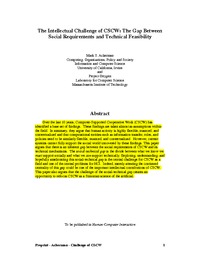 Diese Seite wurde seit 7 Jahren inhaltlich nicht mehr aktualisiert.
Unter Umständen ist sie nicht mehr aktuell.
Diese Seite wurde seit 7 Jahren inhaltlich nicht mehr aktualisiert.
Unter Umständen ist sie nicht mehr aktuell.
 Zusammenfassungen
Zusammenfassungen
Over the last 10 years, Computer-Supported Cooperative Work (CSCW) has
identified a base set of findings. These findings are taken almost as assumptions within
the field. In summary, they argue that human activity is highly flexible, nuanced, and
contextualized and that computational entities such as information transfer, roles, and
policies need to be similarly flexible, nuanced, and contextualized. However, current
systems cannot fully support the social world uncovered by these findings. This paper
argues that there is an inherent gap between the social requirements of CSCW and its
technical mechanisms. The social-technical gap is the divide between what we know we
must support socially and what we can support technically. Exploring, understanding, and
hopefully ameliorating this social-technical gap is the central challenge for CSCW as a
field and one of the central problems for HCI. Indeed, merely attesting the continued
centrality of this gap could be one of the important intellectual contributions of CSCW.
This paper also argues that the challenge of the social-technical gap creates an
opportunity to refocus CSCW as a Simonian science of the artificial.
Von Mark S. Ackerman im Text The Intellectual Challenge of CSCW (2000)  Ackerman reviews CSCW literature and compiles the findings of over a decade of CSCW research. He identifies the gap between social requirements and technical feasibility as the fundamental problem of CSCW.
Ackerman reviews CSCW literature and compiles the findings of over a decade of CSCW research. He identifies the gap between social requirements and technical feasibility as the fundamental problem of CSCW.According to Ackerman, social activity is flexible, nuanced, contextualized and fluid. People prefer to know who else is present in a shared environment, they are very concerned about how and with whom they wish to share information, and they will sometimes resist articulating their real goals. Therefore, incentives are crucial to the success of CSCW systems. People will not share information if they do not get a benefit or reward.
On the other hand, technical systems are rigid and often awkward to use. It is normally not possible to adjust the level of privacy or awareness. People might want their co-workers to know whether they are online but not their manager. Other problems of CSCW systems are for example concurrency issues - several persons work on the same document, and the lack on contextual information - informal communication is missing in CSCW environments, distant co-workers are often more heterogeneous in terms of both knowledge and skills.
The article provides hints on how to overcome some of the shortcomings of CSCW. Features like chat, buddy-list and other communication tools help people to feel less distant and to share a certain amount of context. Ackerman calls these features “first-order approximations” because they do not solve the major problems of CSCW but approximate real-life social settings. He then argues that the socio-technical gap creates an opportunity for CSCW to become a true "science of the artificial", a term introduced by Herbert Simons in 1969.
Ackerman has written a concise overview of CSCW. Novices get a useful introduction to the social and technical findings of the field. The author illustrates clearly that CSCW has an inherent socio-technical gap that cannot be bridged by some merely technical means. However, the call for a CSCW science is slightly exaggerative. [from http://www.elearning-reviews.org/topics/human-computer-interaction/usability/2000-ackerman-intellectual-challenge-cscw/]
 Dieser Text erwähnt ...
Dieser Text erwähnt ...
 Personen KB IB clear | Neil Postman , Herbert Simon | ||||||||||||||||||
 Begriffe KB IB clear | Computervermittelte Kommunikationcomputer mediated communication
, CSCWComputer-supported collaborative work
,  Kommunikation Kommunikation communication communication
| ||||||||||||||||||
 Bücher |
|
 Tagcloud
Tagcloud
 Zitationsgraph
Zitationsgraph
 Zitationsgraph (Beta-Test mit vis.js)
Zitationsgraph (Beta-Test mit vis.js)
 1 Erwähnungen
1 Erwähnungen 
- Virtual Community Maintenance with a Repository (Derek Hansen, Mark S. Ackerman, Paul J. Resnick, Sean Munson) (2007)


 Volltext dieses Dokuments
Volltext dieses Dokuments
 |  The Intellectual Challenge of CSCW: Artikel als Volltext ( The Intellectual Challenge of CSCW: Artikel als Volltext ( : :  , 62 kByte; , 62 kByte;  : :  2021-03-21) 2021-03-21) |
 Anderswo suchen
Anderswo suchen 
 Beat und dieser Text
Beat und dieser Text
Beat war Co-Leiter des ICT-Kompetenzzentrums TOP während er Dieser Text ins Biblionetz aufgenommen hat. Die bisher letzte Bearbeitung erfolgte während seiner Zeit am Institut für Medien und Schule. Beat besitzt kein physisches, aber ein digitales Exemplar. Eine digitale Version ist auf dem Internet verfügbar (s.o.). Aufgrund der wenigen Einträge im Biblionetz scheint er es nicht wirklich gelesen zu haben. Es gibt bisher auch nur wenige Objekte im Biblionetz, die dieses Werk zitieren.









 Biblionetz-History
Biblionetz-History